What plants love moisture. Wet garden plants
Ideal summer cottages does not exist. On some - increased dryness or excess moisture, on others - unusual features of the soil, on the third - elevation changes, on the fourth ground water lie close to the surface. If the soil on the site is swampy or too damp, it is quite possible to do without powerful drainage. To preserve the natural landscape, you need to plant on it suitable plants. Moisture-loving trees and shrubs delight the eye with luxurious foliage and lush flowering.
Specialists who are professionally engaged in landscape design say that there are simply no bad sites for them. Whatever features the site has, it always provides rich opportunities for the implementation of the most daring ideas. It is only important to choose an option that meets specific conditions. In waterlogged areas, you can equip a “wet garden” by planting trees and shrubs on them that tolerate a lack of oxygen in the soil.
Crops for areas with high humidity
Moisture-loving plants are divided into two classes:
- flowering with attractive leaves;
- deciduous-decorative with inconspicuous flowering.
There are lovers of damp soil both among annuals and among perennials. Most of these crops belong to the group of trees and shrubs (for example, viburnum, shadberry, hydrangea) or to the herbaceous class of perennial plants that can live in one place for several decades. Such varieties naturally grow in shallow waters, swamps, and water bodies. They are perfect for artificial landings in summer cottages.
Moisture-loving shrubs and trees have the ability to drain the soil around them. To eliminate excess moisture in a summer cottage, you can plant a birch, which, after reaching maturity, dries the soil within a radius of about 10 meters. The number of moisture-loving trees also includes elder, maple, willow. Examples of moisture-loving shrubs are silver currant, viburnum, cranberry, etc. In a small summer cottage with high humidity soil, fruit-bearing bushes can be planted. However, it must be borne in mind that even moisture-loving plants do not bear fruit on too swampy and damp soil.
Himalayan honeysuckle is one of the moisture-loving shrubs that do not require special care and are very easy to grow. This plant looks very impressive near the reservoir, when its arched green branches, covered with purple flowers, bend over the surface of the water. The best background for growing Himalayan honeysuckle is white turf.
swamp rose
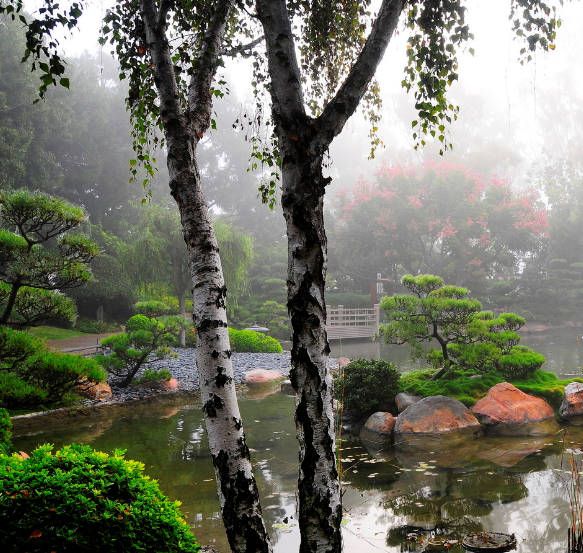
Swamp rose is an upright sprawling shrub up to two meters high. She constantly releases young shoots and grows rapidly. This shrub is also known as the "Pennsylvania rose". It comes from North America. It lives on the coasts of reservoirs and in wetlands, as well as in ravines. Prefers partial shade and bright sunlight.
On purple-reddish shoots there are many thorns, on the edges of pubescent dark foliage - teeth. The appearance of a picturesque openwork crown is complemented by inflorescences of several small flowers. The shrub emits a pleasant aroma. During the summer, the color changes from pink to bright orange. Flowering occurs in July-August.
Swamp rose requires constant care, including the timely removal of young shoots and the annual pruning of old branches. This culture is suitable for creating a spectacular accent. It stands out brightly against the background of decorative leafy plants.
Meadowsweet
Under natural conditions, meadowsweet, also called meadowsweet, grows in water meadows and swampy forests. In a cultivated area, he needs approximately the same conditions. In June, the meadowsweet dissolves white lush lace. Although this plant looks modest in the rest of the months, its hardiness and beauty have led to its high popularity among gardeners.
The most common are varieties with white flowers, but there are also varieties with flowers painted in pink color. Pinnate leaves form a majestic background for paniculate and corymbose inflorescences. Most of all, gardeners appreciate the meadowsweet and Korean meadowsweet, from the pink buds of which white flowers bloom. Withered inflorescences should be cut off, every 5-6 years the bushes are divided and transplanted.
Meadowsweet is planted on the banks of natural and artificial reservoirs, in landscapes, on forest edges. He loves sunlight, but easily adapts to partial shade. Watering is required only when the soil dries.
kaluzhnitsa
The marigold is also known by the names "water snake" and "paddling pool", which reflects the propensity of this beautifully flowering perennial plant to damp swampy areas. On the branched stems of this culture, dense leaves of an almost round shape with a diameter of up to 12 centimeters grow. Attractive golden inflorescences that bloom in April-May give the plant a special charm. Marigold is used to create a spot of color in the foreground of the garden, to decorate a wet flower bed.
The most popular among gardeners are pimento marigold, multi-petal marigold with golden flowers, as well as marsh marigold.
With excessive growth, the separation of the marigold is performed every 3-4 years. This culture needs a lot of sun, but it can do with partial shade under trees with a not too dense crown.
swamp spurge

The euphorbia family includes herbaceous plants, shrubs, shrubs and trees. Marsh euphorbia stands out among them for its love of dampness. Under natural conditions, it grows in water meadows, in the garden it is able to tolerate short-term flooding. AT landscape design with the help of this culture, they form a background for other plantings, create a textural accent, and are used to decorate reservoirs, decorate wet flower beds.
it perennial with a large cylindrical rhizome, it is characterized by unpretentiousness, but at the same time it has aggressiveness and toxicity. Bare bluish shoots are decorated with narrow bright foliage. The inflorescences located on top have a nondescript appearance. After flowering is completed, pruning is performed to thicken the curtains. Once every 3-4 years, marsh spurge is rejuvenated by completely removing the aerial part. This crop requires moist soil and plenty of light to thrive. For tall varieties, you need to install supports.
Loosestrife
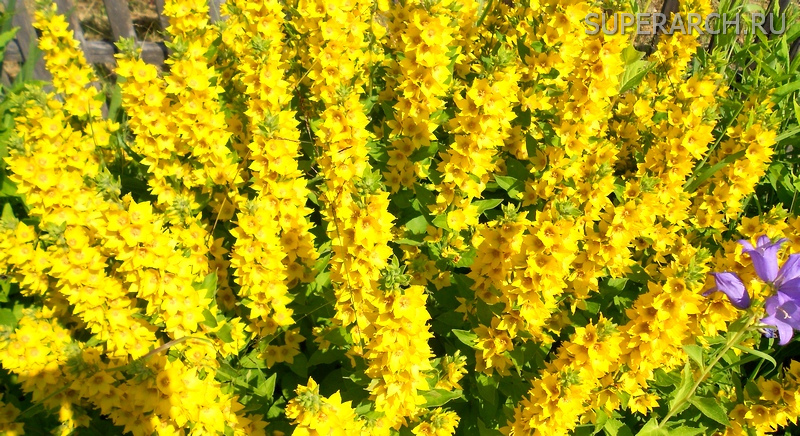
Loosestrife is a perennial plant with straight shoots that form curtains 70-80 centimeters high. This culture is shade-tolerant, but loves sunlight, in which it grows rapidly in big bush, more precisely - in the curtain. The loosestrife tolerates harsh winters well and does not need shelter in the cold season. It has a powerful but shallow root system that tends to cover a large area. For this reason, in order to preserve the beauty of the flower garden, it is necessary to regularly remove excess parts of the bush. When growing creeping varieties, it is required to control their growth, when breeding upright varieties, remove inflorescences and hill up.
The best conditions for growing loosestrife are moderately humid, although it also feels good in waterlogged areas. The loosestrife blooms from May to August. At this time, white, pale yellow or pink inflorescences bloom. After flowering is completed, the faded parts are cut off, due to which the re-bloom which is more abundant.
Thyroid Darmer
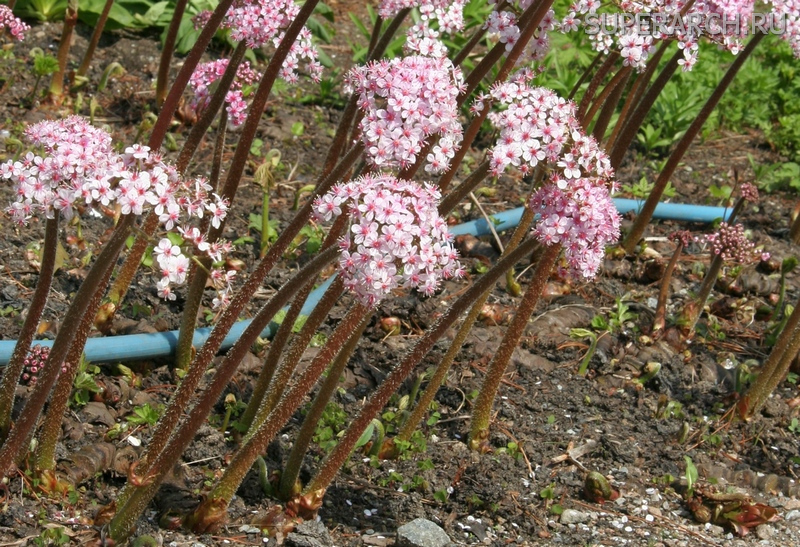
The thyroid darmer is a herbaceous perennial plant with huge leaves. It tolerates cold well winter time. Darmer does not shoot underground shoots, the growth of the bush occurs evenly. The knotty, powerful, thick rhizome of the plant has a diameter of 6 centimeters.
With the help of this culture, they draw up the coasts of reservoirs, large wetlands, it is used to equip damp flower beds. Green leaves with veins and notches are perfect for this purpose. Throughout the season, stains and purple spots appear on them. Flowering occurs in April-May, before the leaves appear. The beauty of delicate pink flowers is emphasized by unusual purple stems.
The best soil for darmers is with a variable level of waterlogging. She does not really like sunlight and prefers partial shade. With excessive growth of the bush, it is divided. Peduncles are recommended to be cut. Top dressing is carried out every spring. The most common variety "Nanum" has a height of up to 50 centimeters.
swamp calamus
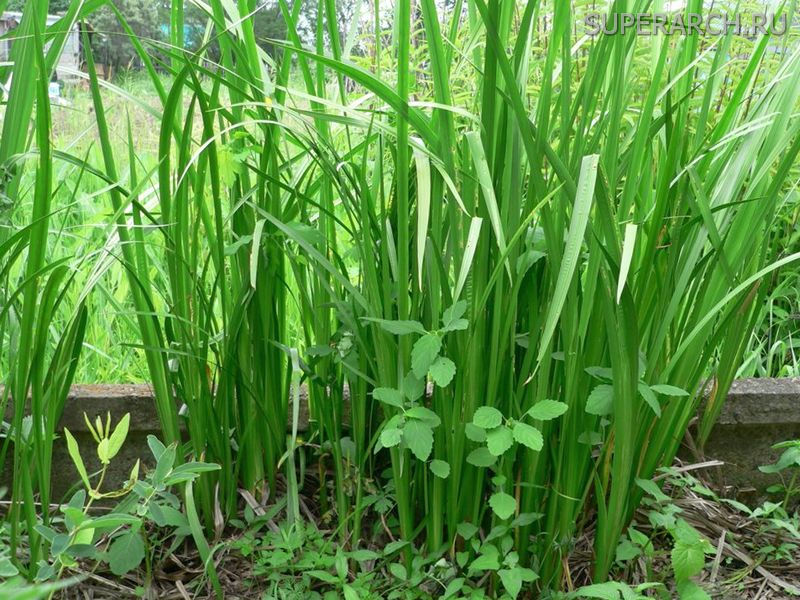
Under natural conditions, marsh calamus grows near lakes, rivers and swamps. Gardeners also breed it in summer cottages. This hardy plant has long bright green leaves with "frilled" edges. It looks great in wetlands. Air loves sunny open areas with fertile, silty, flooded soil. He needs early-flowering neighbors who close curtains in early summer.
This culture must be constantly weeded, with excessive growth, the curtains are separated. The most popular at present is not marsh calamus, but garden variety of this plant with white and cream stripes, called "Variegata". Its showy coloration and relatively low height form a pleasing background and make a strong impression due to its unusual appearance.
Moisture-loving shrubs and trees grow best in nutrient-rich soil. Therefore, to create favorable conditions for them, the acidity of the soil should be reduced and a nutrient substrate should be introduced into it. In addition, such a site must be constantly monitored, preventing the soil from drying out. This is especially true during the summer months when it doesn't rain very often. Although many moisture-loving plants can tolerate short-term droughts, it is advisable to provide them with water in a timely manner.
The best conditions for them can be provided on the well-lit coast of the reservoir. They can be planted on the borders of a summer cottage from the side of a pond or lake as a hedge. Willow and alder have decorative properties during all year round due to the noble pattern of the bark. At various kinds willow bark also has a different color.
In those areas where the soil remains wet for a long time, plants should not be planted in late autumn, since the earth in such areas quickly freezes at this time. It is best to plant them in spring or early summer when the soil is warm enough.
"Piggy bank garden tips»,
edited by Ekaterina Bulanina
woody for heavy clay soil
Many crops can be grown on wet, marshy soils. Trees are the hardest to tame. It seems to have taken root, it grows and pleases. But suddenly, for no apparent reason, it begins to dry, shed its leaves, and after winter it completely disappears. The reason is that the roots have reached the dead gley layer with stagnant water. Majority garden trees will not grow in such conditions, so you can only afford a very limited selection of species.
On soils with short-term waterlogging, where there is no long-term stagnation of moisture, and, accordingly, a dead gley layer, many trees and shrubs adapt well. When choosing woody trees, it is important to correctly assess the ecological features of the breed - frost resistance, shade tolerance, exactingness to soil fertility and acidity.
Conifers
- Spruce could with good reason become a symbol of the Northwest - it is so frost-resistant and unpretentious to growing conditions. Almost all spruces grow in waterlogged conditions, but not all of its cultivars. The varietal variety of spruces for ornamental gardening is great, and if you solve the problem of stagnant water, then almost any Christmas tree will become a welcome guest in your garden. On heavy, moist clay soil, it will not develop as luxuriously as on fertile land. But this factor can be turned into a plus by getting a compact plant shape. ()
- Siberian larch (Larix sibirica) - undemanding to soils, grows successfully on calcareous, podzolic soils, chernozems, better - on loams, poorly - on sands. The soil mixture consists of leafy soil, peat and sand (3:2:1). Drainage only on heavy clays: broken brick with a layer of 20 cm. European larch (L. decidua) and Japanese larch (L. Kaempferi) have many compact decorative forms that are absolutely stable in our climatic conditions. ()
- Juniperus (Juniperus) - generally not demanding on fertility, but requires drainage and does not respond well to soil compaction. On heavy clays, the soil thaws late, and unfavourable conditions, contributing to the spring "burning". It may not happen in the first or second year, but it will happen. Deciding to plant junipers in such conditions, you need to take care of shading your pets from the scorching spring sun. ()
- Fir (Abies) - all firs are demanding on the richness, moisture and drainage of the soil. On damp soils forms a superficial root system. Drainage is required on heavy soils. Balsam fir (Abies balsamea) - up to 8 m high, grows very slowly, frost-resistant and shade-tolerant. Needles with two blue stripes. Prefers acidic soils. It has a dwarf form 'Nana' up to 50 cm high. Korean fir (Abies koreana) is a slow-growing tree up to 10 m high. The needles are bright green, whitish below. Very decorative cones purple that appear already on young plants. The soils are acidic but fertile. Varieties and cultivars are very decorative. Siberian fir (Abies sibirica) is the most well-known representative of the genus, winter-hardy, shade-tolerant, starts growing early in spring and can be damaged by late spring frosts. ()
- Pine (Pinus). Although pines are more associated with dunes and dry forests, some of them still do not disdain wet soils and even swamps. Weymouth mountain pine (Pinus monticola) - a tree up to 30 m high Prefers wet open spaces. The needles are bluish-green with long needles. Cones decorate the tree thanks to their large sizes. Siberian cedar pine (Pinus sibirica) is very decorative due to its powerful dense crown. It grows relatively slowly. Moisture-loving and shade-tolerant, tolerates moderate excess moisture, grows best on loamy moist soils. ()
- Western thuja (Thuja occidentalis) - a tree 12-20 m high, less often a shrub. The crown is pyramidal or ovoid, often descending to the ground. Grows along the low-lying banks of rivers, in swamps, on moist fertile loams. It is winter-hardy, shade-tolerant, but develops better and is more durable in good light. Has many garden forms differing in the nature of growth, color and shape of the needles. ()
deciduous trees
- Birch . In the forest landscapes of the North-West, there are 2 types of birch: drooping (or warty) birch (Betula pendula) - with branches hanging down, and downy birch (Betula pubescens) - with shorter, upward directed branches and white bark even at the base of the trunk. B. fluffy is more adapted to harsh climatic conditions, puts up with high soil moisture, often grows in damp forests, along the outskirts of swamps, lake shores. At the drooping birch there are decorative forms and cultivars with split leaves, purple coloration. Very beautiful grafted forms. All birches contribute to the drainage of the site, they pull water from the soil like pumps. ()
- Willow (Salix). All willows are photophilous, grow quickly, need sufficient air and soil moisture, and tolerate shearing well. They have many decorative advantages: bright shoots, beautiful and abundant leaves, various crown shapes. A very interesting group of dwarf and low-growing willows, which are suitable for rock gardens, rocky gardens, as small groups just against the background of the lawn or in combination with other low and tall shrubs. For these willows on heavy clays, drainage is required. ()
- Red maple (Acer rubrum) is one of the few types of maples that tolerate excessive moisture and even stagnant water. decorative tree up to 20 m high with a large tent-shaped crown. The leaves are three-five-lobed, up to 10 cm long, reddish-green when blooming, dark green above, glabrous, shiny in summer, gray or whitish below, on red petioles, in autumn period acquire an amazing color: the upper side becomes orange, red or purple, the lower one - pinkish-silver. Shade-tolerant. Unpretentious, but demanding on soil moisture, as well as on air humidity. ()
It has several decorative forms: columnar, spherical, three-lobed, Drummond. - Alder (Alnus) is predominantly moisture-loving, but not particularly durable. Refers to soil-improving rocks. It is of interest for the design of the banks of large reservoirs, in groups in parks with soils moist from close groundwater. The speed of growth and the long preservation of green foliage in autumn are valuable properties of alder. Bears do not like alder very much, and its branches are stuck into the ground where this pest is seen. The presence of wild alder indicates the presence of groundwater. The black alder (Alnus glutinosa) has a fairly large variety of species and forms, which differ in the shape of the crown and the shape and color of the leaves as completely different plants.
- Manchurian nut (Juglans mandshurica) - tall tree up to 25 m tall with openwork spreading crown. The leaves are very large up to 1.25 m. It is distinguished by a friendly leaf fall and the shortest growing season. Easily propagated by freshly harvested seeds. ()
- (Padus avium) - a tree up to 15 m high, grows on fertile soils with excessive flowing moisture, photophilous. In May, it blooms with hanging white racemes, the aroma of which fills all the surroundings. Everyone knows black edible drupe fruits. It has a number of decorative forms: weeping; variegated, with yellow and white-variegated leaves; terry; rosaceous - with pink flowers; as well as yellow-fruited.
shrubs
- Aronia chokeberry (Aronia melanocarpa) grows in swamps and lowland forests, sometimes on more drained soils, pebbles of sea coasts. Often call " chokeberry”, from which it differs in the shape of the leaves. Deciduous shrub up to 3 m. Leaves in autumn are painted in bright red-purple tones. The flowers are white, rarely pinkish, fragrant, reminiscent of mountain ash. The fruits are round, black-purple with a bluish bloom, shiny, up to 1 cm, quite juicy, edible, somewhat astringent in taste. Very interesting hybrids of aronia chokeberry with mountain ash.
- Canadian elderberry (Sambucus canadensis) - fast growing shade tolerant ornamental shrub up to 3 meters high. Grows well on acidic loamy soil with close standing groundwater. It has several decorative forms. ()
- The red elder (Sambucus racemosa) grows as a shrub or small tree. The flowers are green-yellow, the berries are bright red, the leaves and branches are bad smell. It is very beautiful during the fruiting period, especially when grown in standard form. More often decorative forms are used (nana, plumosa, tenuifolia, purpurea, flavescens). ()
- Voskovnitsa common (marsh myrtle) (Myrica gale) is found in damp meadows and grassy swamps in coastal areas. Deciduous upright shrub up to 1.5 m Leaves dark, narrow, up to 6 cm long Blooms before the leaves bloom. Men's and women's earrings are located on different plants. Mature fruits are hidden among brown scales, as in a cone, up to 1 cm long.
- Hydrangea tree (Hydrangea arborescens) - sprawling shrub up to 1.5 m Flowers greenish or creamy white, collected in corymbose inflorescences, blooms in July-August. Shelter is recommended in winter, but after partial frosting and pruning, it quickly grows back, blooming in the same year. Prefers rich, moist soils and protected areas. ()
- Panicled hydrangea (Hydrangea paniculata) - a spectacular shrub with rare branching, up to 2 m high.Inflorescences are large, cone-shaped, white-pink, blooms in July-September. Frost-resistant look, demanding on soil fertility, tolerates shading. Has many varieties different term flowering. ()
- Daphne (wolfberry) deadly (Daphne mezereum). Rarely exceeds 1 m in height. Remarkable for its very early colorful flowering. The flowers are small, very fragrant, in bunches of 2-5 or solitary, sitting directly on the trunk, lilac-pink or pink-lilac in color. Daphne grows slowly, but hardy. Decorative form with white flowers (f. alba) grows faster. Grows well in semi-shaded places. At the end of summer, the branches are covered with bright red, and in the Alba form with yellow shiny berries. All parts of the plant are poisonous.
- White Derain (Cornus alba) is a large sprawling shrub up to 3 m high with raspberry shoots, tolerates flooding, and is well cut. It has decorative forms and varieties with bordered leaves. It is better to plant in a lit place to achieve a spectacular coloring of the foliage. Good for creating undergrowth, hedges, can be grown in standard form. ()
- Irga spiked (Amelanchier spicata) - deciduous shrub up to 5 m tall is characterized by rapid growth and winter hardiness, beautiful flowering and abundant fruiting. Easy to cut. In summer, dark green foliage turns bright orange-red in autumn. ()
- Kalina (Viburnum). Common viburnum (V. opulus), viburnum (V. lantana) and Canadian viburnum (V. lentago) are most often grown, but viburnum Sargent (V. sargentii) is most suitable for waterlogged areas. It is undemanding to the soil, prefers low places with running water. Shade-tolerant, winter-hardy. A good ornamental shrub, especially spectacular at the time of flowering and fruiting, in single and group plantings, along the banks of reservoirs. Withstands frosts down to -30°C, prefers sunny places, but also tolerates partial shade. Like the common viburnum, it is a good honey plant and has similar healing qualities. It is very beautiful not only when flowering, but also in autumn, when the leaves are painted in bright scarlet tones.
- Cotoneaster brilliant (Cotoneaster lucidus) - one of best shrubs to create sheared hedges. Decorative and pink flowers, collected in loose corymbose inflorescences, and black shiny fruits that remain on the bushes until late autumn. ()
- Rose wrinkled (Rosa rugosa), this species is easily recognizable by wrinkled leaves. Lilac large non-double flowers open all summer on the shoots of the current year and on last year's shoots. By the end of summer, buds, flowers and ripened fruits can be observed on the bushes. There are white, pink and terry forms. Good in single planting, in groups and in hedges. (
- Fieldfare (Sorbaria sorbifolia) is a shrub up to 3 m tall with leaves resembling mountain ash. Vegetates one of the first, blooms profusely within a month. Easily withstands a haircut. Gives abundant root offspring, forming dense thickets. ()
- Black currant (Ribes nigrum) in addition to the harvest has a number of irreplaceable decorative advantages: fast growth, frost resistance, late leaf fall. Good for border and single plantings. There are varieties with a compact crown, with dark green glossy dense leaves, as well as split-leaved, variegated and marbled forms. ()
creepers
- Petiole hydrangea (Hydrangea petiolaris) is a liana up to 20 m high.In the first years after planting, it builds up the root system and growths are weak, then the shoots grow faster. Blooms in July-August with white flowers. Shade-tolerant, demanding on soil fertility, prefers moist loams. Winter hardiness is average, so shelter from cold winds and frost is required.
- Parthenocissus quinquefolia - large climbing liana up to 15-20 m Common plant of moist forests and thickets of shrubs on moist rich soils. The leaves are compound, palmate. Grows very fast, shade tolerant. It is very frost-resistant, without shelter it can develop north of St. Petersburg, it grows on any soil, it tolerates the conditions of the city well. ()
- Round-leaved tree pliers (Celastrus orbiculata) is an elegant liana with a strongly branched crown up to 12 m high. The flowers are inconspicuous greenish, bright yellow fruits remain on the plant all winter. Whip-shaped tree plier (Celastrus flagellaris) is a deciduous vine that rises to a height of 10 m, rarely creeping, with easily rooting shoots. The leaves are light green, with a finely serrated edge. Stipules in the form of spines bent downwards, with the help of which the vine clings to the bark of trees or the ground. Requires rich soils with high humidity.
- Honeysuckle honeysuckle (Lonicera caprifolium) is the most common of curly honeysuckle; it is quite frost-resistant, hibernates under snow, photophilous, demanding on fertility and soil moisture. The flowers that appear in early summer are very fragrant (especially in the evening), white or yellowish inside, purple or reddish outside. Orange-red berries ripen in early August and decorate the vine until late autumn. (More about honeysuckle
- For the same purpose, use peat and organic compost, they have a loosening effect, increase water permeability and improve the water regime.
- When digging, add crushed brick. Finely crushed brick is scattered on the ground with a layer of 9-13 cm and then, together with fertilizer, is applied to the soil. By repeating this operation for several years in a row, it is possible to improve the soil beyond recognition, and the results are the better, the deeper the digging is done.
- Brick can be replaced with burnt weeds: for this, a fire is laid out of brushwood, lit, and then weeds with roots and earth adhering to them, vegetable waste, spoiled straw, turf, etc. smoldered inside the fire. The ash obtained in this way is used instead of crushed bricks.
- More top scores can be obtained if peat is used for burning.
- It is possible to improve the properties of clay soil by introducing plant residues, as well as needles, sawdust, which should be dug in in autumn or early spring.
- Composting is one of the the best means increasing fertility and improving the structure of clay.
- Soils with high acidity are very responsive to the introduction of ash. In addition to neutralizing the acidic environment, ash adds nutrients, improves the structure of the soil, destroying the solidity of the clay. The accepted norm is 1 glass per 1 sq. m, but more is allowed - 2-3 glasses.
- Ash, lime or dolomite flour apply after digging, scattering on the surface of the earth. The optimal time is autumn, so that fertilizer with rain and melt water gradually penetrates to the depth. In such conditions, the soil ripens better. It is less effective to apply deoxidizers in April for digging.
Hygrophytes - this is the scientific name for plants that prefer excessive moisture. They do not tolerate heat and drought, but they are unpretentious in care and do not particularly suffer from diseases and pests, they feel great in the shade. Moisture-loving include: willow, viburnum, birch, elderberry, currant, cranberry. A good example is birch. Plant it in a place where groundwater is close, and it will dry the soil near it 6 meters deep. And more mature tree, fifteen years old, will dry the earth for ten meters! But even moisture-loving plants in too damp areas will not take root. In such cases, drainage is necessary.
About those who love humidity
What cannot be solved in a standard way, you can try creatively. Let's consider the problem as a feature of the landscape and look for appropriate landscaping. When moisture bothers only a small part of your possessions, then everything is even easier. Nowadays, natural design is becoming popular. Build a pond, plant willows, create a decorative composition natural beauty. Another issue is dampness in the garden. Fruit trees don't really like places like this. Few of them are able to grow and develop in such an environment, although there are some.
 Such moisture-loving trees and shrubs for summer cottages are known:
Such moisture-loving trees and shrubs for summer cottages are known:
- plum, quince, dwarf apple and black currant are the best. These plants can be planted even when groundwater at a depth of 2-3 meters;
- pears and apple trees on a vigorous rootstock are less tolerant of high humidity. But it makes sense to try to grow. Important point when landing - bulk mounds. And it is even more effective to put a piece in the hole sheet metal. This will help the roots grow wide and avoid water in the depths.
You will have to forget about cherries and cherries in such a garden or find the driest site for them. Do you want to grow raspberries, hazel, currants? There is such a possibility. Dig ditches for drainage around the perimeter of the site. Fill high hills and boldly plant berry bushes on them.
Not in dampness, but in the shade
Often there is another problem - shady areas. Rare horticultural crops will be able to live there. Especially if it is a dense shadow with north side buildings, and not from another tree. Greenery from trees and bushes will transform the dull look of such places. And if they are fruitful, then, in addition to the variety of foliage, you will also get a harvest. What will fit:
- raspberry;
- currant;
- dogwood;
- hazel;
- blackberry;
- viburnum;
- gooseberry;
- barberry;
- honeysuckle;
- Apple tree;
- elder.
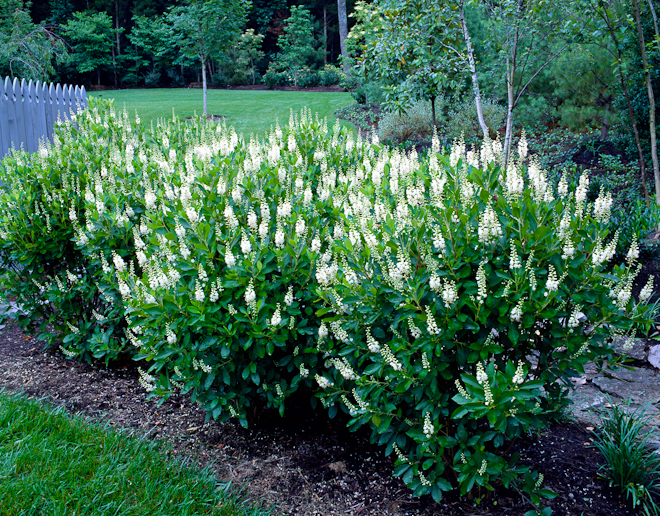 Currants are the best choice for shade. It is unpretentious in care, multiplies quickly, winter-hardy, tasty and healthy. Diversifies appearance plot also elderberry. It protects the garden from pests and has healing properties. Kalina will especially please you. Carved leaves, beautiful flowers, bright and healthy berries. Rosehip feels comfortable in the shade. In summer, it attracts bumblebees with its delicate flowers, and in autumn it will bear fruit. Dry these berries and enjoy fragrant tea in winter. Raspberries will be able to bear fruit in a shaded, but not too damp place. Raspberries and apple trees do not take root well, so place them in different parts of the garden.
Currants are the best choice for shade. It is unpretentious in care, multiplies quickly, winter-hardy, tasty and healthy. Diversifies appearance plot also elderberry. It protects the garden from pests and has healing properties. Kalina will especially please you. Carved leaves, beautiful flowers, bright and healthy berries. Rosehip feels comfortable in the shade. In summer, it attracts bumblebees with its delicate flowers, and in autumn it will bear fruit. Dry these berries and enjoy fragrant tea in winter. Raspberries will be able to bear fruit in a shaded, but not too damp place. Raspberries and apple trees do not take root well, so place them in different parts of the garden.
Of course, the most right decision for draining the soil of a garden or personal plot is drainage device . Especially when it comes to landscape design and site design is not an issue at all. By the way, I have a good article about this on my personal website, with a description of the most proven methods for arranging drainage in garden and summer cottages. If anyone wants, they can read “How to dry a summer cottage?” .
But sometimes there is such a situation when it is simply impossible to perform ideal drainage, for example there is no way to divert groundwater due to the built-up area or, as often happens, lack of finance. And I want to decorate the site, and at the same time it’s nice to have a garden on the site, or at least fruit-bearing shrubs.
In this case, well-known ornamental or fruit plants can come to our rescue. For example, using eucalyptus saved the area of Pitsunda in Abkhazia from swamps and mosquitoes. Of course, eucalyptus does not grow here, but it turns out that there are many other plants with which you can dry and at the same time .
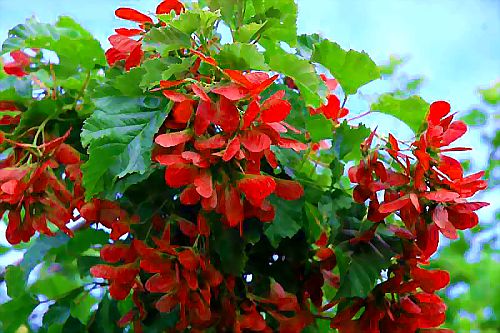 Maple Tatar - photo.
Maple Tatar - photo.
We will focus on the middle lane, what is suitable for it is naturally suitable for more southern regions.
About poplars, of course, you all know that poplar is eucalyptus for middle lane Russia, but recent times and, probably, rightly they began to refuse it, because of the huge amount of fluff during the flowering period, and where there is fluff, there is an allergy. There are also pyramidal poplars, but the shadows from them are smaller and they grow very quickly and at the same time have a low-lying root system. They dry quickly and very often fall even with weak gusts of wind, while damaging our property. Therefore, we will forget about poplars. I advise you to plant only those lucky ones who have a river in their garden. Ordinary poplar strengthens the coastline well and creates . Naturally, poplar is not suitable for our garden plots of six acres, its crown can cover a couple of acres.
And now about those plants that are ideal for draining the backyard.
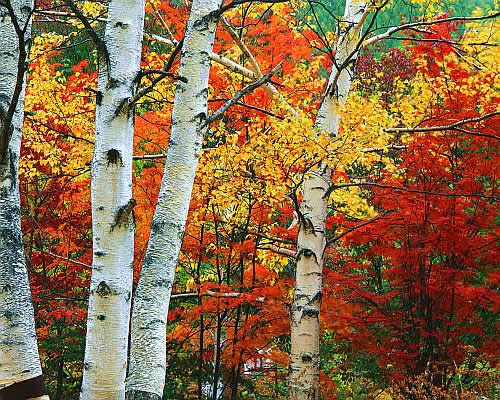
The birch is fluffy.
If you have household plot perfect water drink for him downy birch. A couple of three trees planted at the bottom of the site or a water outlet on the site and the problem of flooding from spring to autumn will be solved. Although root system birch is very developed, the roots do not penetrate deep into the soil, so the trees can be subjected to windblow. Downy birch is the most cold-resistant of birches.
Please note that in the article I have already mentioned local drainage for the second time, if general drainage is not possible, or it is not possible to divert groundwater outside the site, anyway, the site must be planned with a slight slope and local drainage should be drawn to the lowest point. And at the place planned for planting, which will help you drain the soil, arrange drainage well, his optimal dimensions 3x3 meters. It is even better if there are several such wells, they will be connected by a pipe system and a tree is planted near each.
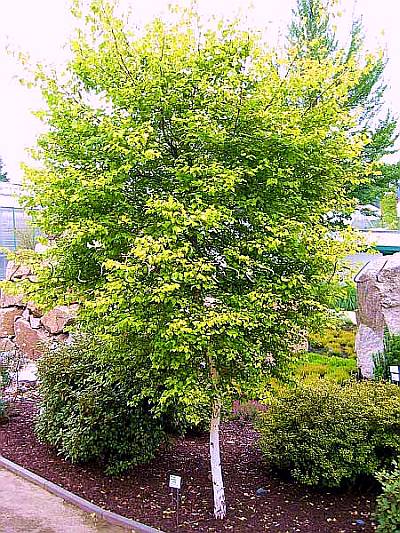
Pits for planting trees for draining the site, it is also necessary to prepare a little differently than during a normal landing. As I already mentioned, the root system of trees for draining the site is very well developed and lies at a depth of 60-80 cm. In this regard, the planting pit for plants used in draining the site should be a meter per meter in size and also at least 0.8 meters deep. . Bottom part landing pit should be 50 centimeters filled with a large stone, the simplest and cheapest of all is a plastic, interspersed with the ground, the stone (but not the brick) will become a support for the roots and create additional drainage. This method of planting trees used to drain the site should be followed for any plants.
 Maple red.
Maple red.
For draining and at the same time decorating a personal plot in landscape design, it is also used alder, larch, ash and Tatar maple. A separate page is dedicated to each of these plants on the site, you can go to it by clicking on the corresponding highlighted word. I will dwell in more detail only on the ash tree at the end of the article, I have a separate story associated with it with landscape design.
What fruit plants for draining the soil are best planted in the garden?
There is only one contender here - plum. Despite this, the plum has so many subspecies that you can easily choose the right one for your garden. Do not forget that the main thing is not the variety or variety of plum, but the stock on which it is grafted. It is the roots that grow in the soil and react to it.
But since an ordinary gardener who purchases plants in a nursery, and most often from his hands, does not have the opportunity to influence the stock, let's do it easier. Just trust my experience and take for granted what is best renklody drain the soil, but they are also more demanding on the soil, therefore good growth and you will achieve abundant fruiting of the plum by planting it according to the technology described above.
 Thornosliv.
Thornosliv.
But the least worries and a wonderful harvest of fruits gives thorn plum . Sort her too great amount, compact trees, can be planted three meters apart. At the same time, the thorn plum practically does not suffer from pests, unlike the usual plum. And of course, cherry plum is suitable for completely lazy summer residents. Her modern views have rather large and tasty fruits, unlike those that we are used to seeing everywhere.
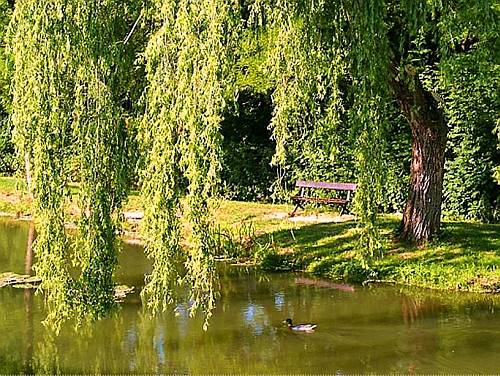
And now about best plants, about which in Russia they compose fairy tales and sing songs. weeping willow. It is suitable for any site, whether it be a garden, a summer residence or a personal plot. The weeping willow can look like a tree or shrub and has over 600 species and varieties. Some varieties of willow certain conditions, grow only 20 cm high. That is why weeping willow is considered the best of the plants that help drain the soil and at the same time it easily fits into any landscaping project.
And finally, as promised, a story about an ash tree, from the life of a landscape designer. .
Florists and gardeners, owners of dachas consider excessively moist areas to be problematic. Choice flowering plants for such habitats is limited, but they exist. With the help of moisture-loving crops (hygrophytes), you can create an attractive garden corner, a flower garden that delights with juicy bright colors throughout the season.
Constant excess moisture soil is an undesirable factor for most plants, making it difficult for the root system to breathe. The soils of such habitats are usually heavy, clayey, structureless (one of the options is peat-acidified, poor in nutrients). Water stagnates due to the lack of proper flow and drainage. Moisture-loving lowland cultures, swampy areas are suitable, there are plants among plants that tolerate shading.
Hygrophytes need constant moisture for normal growth and development, they do not tolerate drought well. The list of other requirements is short, such plants are usually unpretentious, they are little susceptible to diseases, and are almost not damaged by pests. Most bloom beautifully, and the leaves and stems have a special emerald hue.
For many years, the delicate yellow corollas of simple and terry forms of marigold and bathing suit, the luxurious raspberry color of the loosestrife, the multi-colored primrose carpet, the tenderness of forget-me-not, the greenery of the host will please the eye. Among moderate moisture-loving plants- aquilegia (catchment), bergenia, periwinkle. The gardener can pick up perennials, with different flowering times and colors, maintain an elegant look of the marshy garden plot from spring to autumn.
Plants that prefer moist soils:
Perennials:
Aquilegia
Aconite
badan
basil
loosestrife
Avens
Lipstick
Gunner
Loosestrife

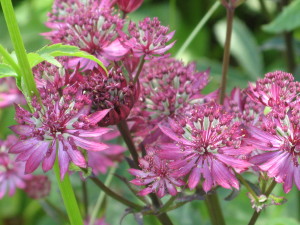

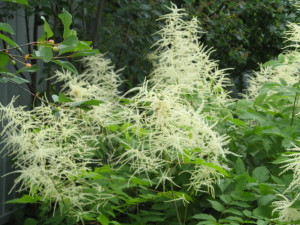
Hedgehog
tenacious
chickweed
kaluzhnitsa
bathing suit
bathing suit
Meadowsweet
Litrum
Lychnis
Lobelia - purple - sparkling
Buttercups
Cuff

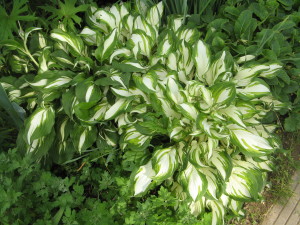
forget-me-not
Fern - Onoklea - Osmunda - Ostrich
herbaceous peony
Poskonnik
umbilicus
Rhubarb
Rogersia
Tradescantia
Violet
Cimitifuga 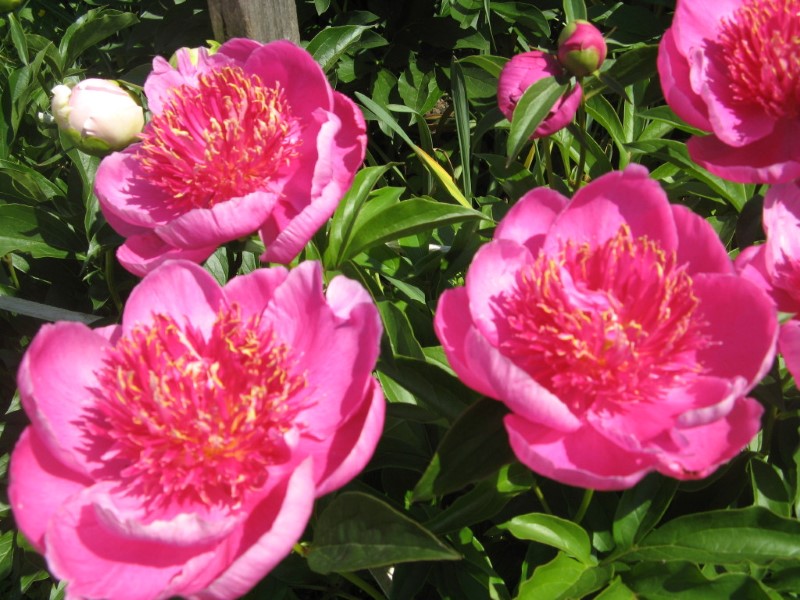

Shrubs for wet areas
Elder
Deren
Willow
Irga
viburnum
Fieldfare
bird cherry

